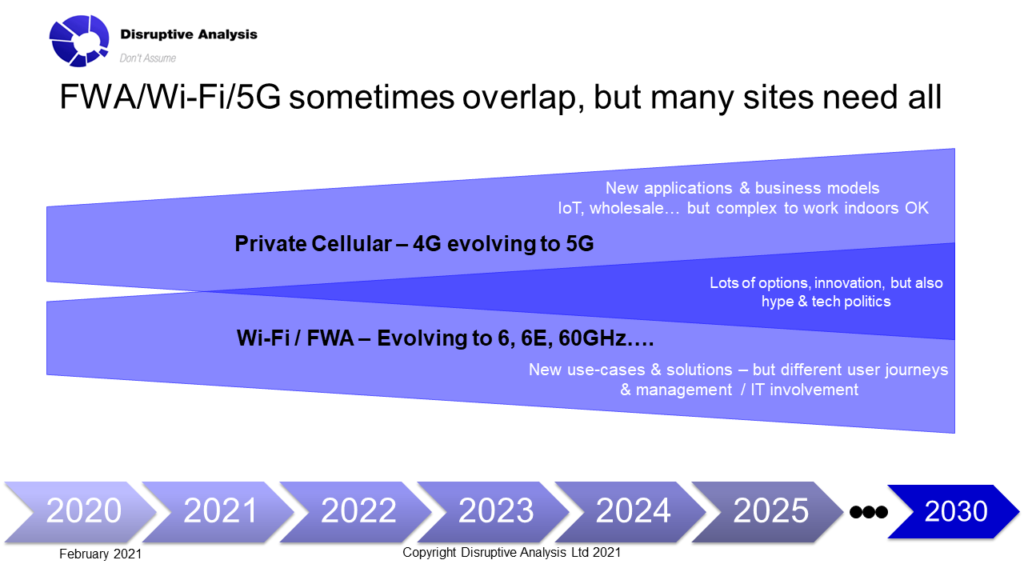We will see various hybrid wireless deployments in enterprise, industrial and community settings in the coming years. Private 5G will coexist with Wi-Fi and many forms of Fixed Wireless Access (FWA) for different applications and use-cases.
There is a huge upswing of interest around the concept of private mobile networks, especially using 5G. In several countries, enterprises are now able to deploy localised or application-specific cellular infrastructure for connecting machinery, people or structures. Manufacturing, energy, logistics and transport hubs are in the vanguard, with healthcare and smart-city municipalities also involved.
While there are around 1000 dedicated 4G LTE networks already worldwide, the extra abilities afforded by private 5G are now becoming real – such as gigabit-speed mobile connections, and potential support for ultra-low latency connections with full mobility.
This trend is being fuelled by new options for spectrum, along with a growing ecosystem of vendors supplying radio equipment and software/cloud-based cores and other elements. Governments see private 5G as a means to accelerate industrial transformation and derive economic growth. There is interest both among normal mobile operators to offer private “slices” of their main national networks and for enterprises or their managed solution providers to create dedicated local infrastructure, using local spectrum licenses.
However, despite these advances, cellular connectivity is almost never going to be the only connectivity type employed, despite some hype from evangelical 5G purists. Even on (rare) greenfield sites, the sheer diversity of automation systems, devices and physical environments will mean that multiple technologies are used.
Private 5G for campus/industrial deployments will almost always coexist with Wi-Fi and FWA connectivity.
It helps to think about the scale and heterogeneity of some of the typical large-scale enterprises involved:
- Manufacturing: A facility may have 10+ separate buildings for different functions, with solid walls with poor outdoor-to-indoor wireless propagation. There will be outdoor storage yards, automated moving vehicles, metalwork (piping and containers) and possible RF interference from motors and welding equipment. Inside the factory buildings there may be ultra-demanding precision robotics, cameras and safety systems, as well as humans with AR goggles and computing devices in close proximity.
- Oil and Gas: An oilfield may have numerous production well-heads dispersed over a wide area. Each will have multiple items of equipment located close by, perhaps with some inside enclosures or underground. Trucks may occasionally need access across the whole region, while low-power sensors of various types will send data intermittently to a central facility. There will be various fixed buildings for staff, computing and equipment.
- Port: A port will have large numbers of moving vehicles, belonging both to the facility itself and independent trucking companies. It will have large mobile cranes, perhaps equipped with high-definition video cameras and remote control from a central tower. Staff will use two-way radios, and there will be a need to communicate with ships’ crews and numerous supporting organisations such as insurance and health-inspection teams. Thick-walled warehouses, office structures and passenger terminals will have further communications needs. There will be high-security perimeter fences. There is a constantly-shifting landscape of metal containers, sometimes stacked 5-6 high.
- Hospitality: A large resort may have several hotel towers, large outdoor areas such as pools and golf courses, convention halls, sporting buildings, residential villas and numerous storage facilities. It may be some distance from urban areas, perhaps even on its own island. A large retirement community or military base could be in the same category, with numerous individual houses, plus vehicles and other buildings.
All of these are “campus” or “community” settings. They will need multiple wireless (and wired) connections to address hugely different use-cases and needs.
They have multiple buildings, outdoor areas with mobile vehicles and humans, a mix of “IT-controlled” and employees’/visitors’ own devices, and potentially hundreds of different applications. These could range from a 5G-connected drone, to Wi-Fi for an outdoor auditorium or sports pitch. Automated vehicles might need 4K cameras connected to edge-compute for analytics and AI, while a second campus on the other side of a highway will need point-to-point or mesh connections.
Connectivity to a building or structure will need to support many use-cases and devices inside it. There will be a variety of local regulations on spectrum, RF emissions, interconnection, lawful interception and more. There will be a need for some devices to connect to a public (MNO) 4G or 5G network, or roam onto it.

This means that such locations will need both cellular (4G/5G) for some applications, and WiFi/FWA for others. While there may be an overlap in some cases, the trajectory of both technologies means that more unique applications are being created at the same time.
Relevant hybrid models include:
- FWA links to individual buildings, connecting to both indoor Wi-Fi and providing backhaul for private 5G small-cells.
- Private 5G outdoor coverage for on-campus mobility (vehicles, push-to-talk handhelds etc) combined with FWA for connecting structures and machinery.
- Ability to use multiple spectrum bands on-site, with some suitable for FWA/WiFi (eg 60GHz) and others usable for 5G mobility (eg 3.8-4.2GHz)
- Single spectrum licenses for a whole area (eg CBRS PAL) with multiple different use-cases for mobility and FWA – such as tenants’ smartphones plus many individual buildings.
- Urban / metropolitan service providers (or municipal agencies) enabling FWA, outdoor Wi-Fi and neutral-host wholesale 5G small cells, delivered and backhauled from the same 60GHz mesh.
It is also important to realise that most localised “private 5G” spectrum bands (such as US CBRS, Germany’s 3.7-3.8GHz, or UK 3.8-4.2GHz and indoor 26GHz) are actually “technology neutral”. As long as radios can conform to the rules on power and interference, they don’t have to be 3GPP 5G NR – they can also use Wi-Fi, 4G LTE or other technologies. This means that they can be used for dedicated FWA connectivity, as well as private cellular.
This has implications for enterprises, solution vendors, network operators and systems integrators. Even with the advances expected from private 5G (which will mature in phases over 3-5 years), there will remain growing applications for FWA and Wi-Fi in different spectrum bands as well.
There will be no “technology monoculture” – companies will use the best tool(s) for the job, often combining multiple wireless standards and fibre on the same site. Enterprise and industrial campus connectivity will require pragmatism, rather than technology religion.
This article has been written by Dean Bubley of Disruptive Analysis (@disruptivedean), an independent telecoms industry analyst and futurist. He covers a wide array of mobile and wireless sectors, including technology and policy issues. He has covered private cellular networks and Wi-Fi for over 20 years. He can be reached via www.linkedin.com/in/deanbubley/
Dean will be the moderator of one of the Cambium Connections (Session 2) online events which will explore the opportunities and strategies on the future of wireless communications. This free session will be held February 25, 2021. Click here for details and registration.
